
Exposure to outdoor air pollution in the month before birth dramatically increases the odds of newborns being admitted to neonatal intensive care units (NICU) in the U.S., new research suggests.
Researchers found higher levels of nitrogen dioxide (NO2) and fine particulate matter (PM2.5) increase the likelihood of NICU admissions nationwide by 30–35% and 11–22%, respectively, according to a population-based study of 3.6 million single babies published Jan. 2 in Scientific Reports.
These findings are regardless of the time of year and even after adjusting for parental factors, including smoking, the researchers say.
“Despite the relatively low-moderate US exposure levels, traffic-related pollutants near the end of pregnancy appear to increase overall adverse health risks for newborns, underscoring the need to reduce prenatal exposure to ambient pollutants,” the researchers say.
Nitrogen oxide and fine particulate matter (tiny particles typically 5mm or smaller) are common combustion byproducts of motor vehicles and power plants, among other sources. The study also investigated ground-level ozone (O3), a colorless gas. Unlike “good” ozone in the upper atmosphere, which protects us from the sun’s ultraviolet rays, this emission type is the primary ingredient in “smog.”
For pregnant people and their newborns, short- and long-term exposure to outside air pollutants can lead to a higher chance of preterm birth and low birth weight. It can also contribute to serious pregnancy complications such as gestational diabetes, hormone imbalances, birth defects, and high blood pressure (hypertensive) disorders of pregnancy, including preeclampsia.
These conditions often occur during late pregnancy and require NICU admission for monitoring and medical care. Outdoor air pollution exposure in pregnancy and early life has also been found to harm children’s brain development and cognition (ability to learn and process information).
The study found:
- For NO2, the risk of NICU admission followed a clear pattern across all seasons—higher NO2 levels were consistently linked to higher chances of NICU admission. Due to increased NO2 exposure, the Midwest and mid-Atlantic regions had the highest risk for NICU admission.
- For PM2.5, the risk of NICU admission varied by season. However, some areas, like the West Coast and the Southeast, showed higher risks year-round. In the summer, higher risks were seen across the country, while in winter, the risks were mainly higher in the Northeast.
- Multiple pollutants together showed similar trends, with slightly weaker results. Results for the month of birth were also consistent with findings for the month before birth.
The findings reinforce other data showing the health risks of air pollution at a time when NICU admissions in the U.S. are anticipated to grow, with up to 13% of babies needing care.
Consider:
- One study, published in 2019, found that exposure to PM2.5 in the week before birth was linked to a 16% to 147% higher risk of babies having to stay longer in the NICU.
- A September 2024 report found that prenatal exposure to air pollution leads to more hospitalizations and filled prescriptions in the first 10 years of life.
- Another study, published this month [Jan. 1, 2025] in Ecotoxicology and Environmental Safety, suggests that airborne particulate matter is linked to congenital (at-birth) defects in newborns, including gallbladder, bile duct, liver, and reproductive organ abnormalities. “The insidious rise in air pollution levels is increasingly implicating its detrimental effects on fetal and neonatal health,” that study’s authors conclude.
For this research, the team conducted a cross-sectional study using national data from 2018 birth certificates, which included about 3.6 million single babies—including 8.1% (about 294,000) who were admitted to the NICU.
The researchers then compared birth data to satellite-measured air pollutants, focusing on the impact of NO2 and PM2.5 levels averaged over the month before birth. Satellites monitor air pollution over a large area (including areas without ground-based air quality monitors) and track changes over time.
The researcher noted that they did not look at other environmental factors, such as noise and indoor air pollutants, which could contribute to risk. They also noted that rural areas often have less access to NICU care, and infants in these areas might only be transferred to a NICU for serious problems.
To reduce the potential impacts, pregnant women may be advised to limit their time outdoors on days with poor air quality. You can also check AirNow or PurpleAir air quality reports in your area. Special note: For those in a wildfire smoke event, wear a NIOSH-approved N95 respirator.
Reference
Phiri YV, Canty T, Nobles C, Ring AM, Nie J, Mendola P. Neonatal intensive care admissions and exposure to satellite-derived air pollutants in the United States, 2018. Scientific Reports. 2025;15(1). doi:10.1038/s41598-024-84755-9
Related
- Coker ES, Martin J, Bradley LD, Sem K, Clarke K, Sabo-Attwood T. A time series analysis of the ecologic relationship between acute and intermediate PM2.5 exposure duration on neonatal intensive care unit admissions in Florida. Environ Res. 2021;196:110374. doi:10.1016/j.envres.2020.110374 [Abstract]
- Noghanibehambari H, Bagheri H, Salari M, Tavassoli N, Javid R, Toranji M. Breathing in the future: prenatal exposure to air pollution and infants’ health outcomes in the USA. Public Health. 2023;225:198-205. doi:10.1016/j.puhe.2023.10.012
- Seeni I, Williams A, Nobles C, Chen Z, Sherman S, Mendola P. Acute air pollution exposure and NICU admission: a case-crossover analysis. Ann Epidemiol. 2019;37:64-70.e2. doi:10.1016/j.annepidem.2019.07.008









